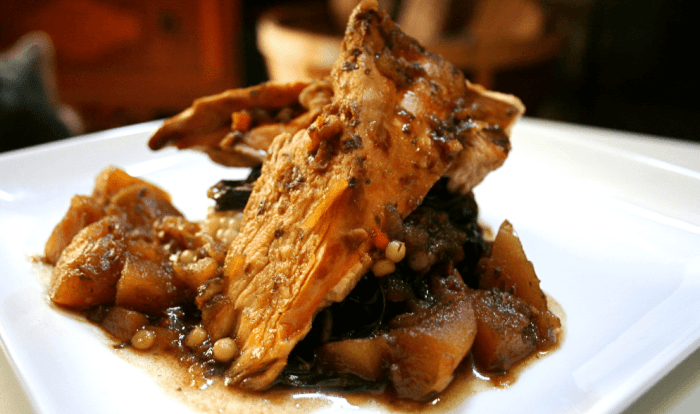
Prepare to embark on a delectable culinary adventure with our captivating Chicken of the Woods recipe. This extraordinary mushroom offers a unique taste experience, and we’ll guide you through its preparation, showcasing its versatility and health benefits.
From foraging tips to tantalizing recipes, this comprehensive guide will turn you into a master of Chicken of the Woods cuisine. So, gather your ingredients, sharpen your knives, and let’s dive into the world of this delectable delicacy!
Introduction to Chicken of the Woods
Chicken of the Woods, also known as Sulphur Shelf, is a vibrant and highly sought-after edible mushroom. It’s characterized by its bright orange to yellow hues and a chicken-like texture and flavor when cooked, hence the name.
Craving a meaty mushroom dish? Look no further than chicken of the woods! This edible fungus is a vegetarian’s dream, boasting a texture and flavor remarkably similar to chicken. For a culinary adventure, check out this chicken of the woods recipe that will tantalize your taste buds.
Its unique umami flavor pairs perfectly with hearty sides like roasted vegetables or mashed potatoes.
This mushroom grows in clusters on the trunks and fallen logs of oak trees, and is primarily found in North America and Europe. It’s prized by mushroom enthusiasts for its unique taste and ease of identification.
Nutritional Value
Chicken of the Woods is a nutritious mushroom, rich in fiber, vitamins, and minerals. It contains high levels of vitamin D, which is essential for bone health, and is also a good source of potassium, phosphorus, and antioxidants.
Culinary Uses of Chicken of the Woods: Chicken Of The Woods Recipe

Chicken of the Woods boasts remarkable culinary versatility. Its firm texture and savory flavor make it a delectable addition to various dishes.
To prepare Chicken of the Woods, it is recommended to slice it into thin strips or chunks. The mushroom can be sautéed, roasted, or grilled. Sautéing with butter or olive oil brings out its umami richness, while roasting intensifies its earthy notes.
Grilling imparts a smoky flavor that complements the mushroom’s inherent savoriness.
Flavor Profile and Pairings
Chicken of the Woods possesses a unique flavor profile, often described as a combination of chicken and seafood. Its earthy, slightly sweet taste makes it a versatile ingredient that pairs well with a range of flavors.
- Savory Herbs:Thyme, rosemary, and sage enhance the mushroom’s earthy notes.
- Citrus:Lemon or lime zest adds a refreshing acidity that balances the mushroom’s richness.
- Garlic and Onions:These aromatic vegetables complement the mushroom’s savory flavor.
- Mushrooms:Combining Chicken of the Woods with other mushroom varieties, such as shiitake or oyster mushrooms, creates a flavorful and complex dish.
Health Benefits and Nutritional Value

Chicken of the Woods boasts an impressive nutritional profile and potential health benefits. It is a rich source of vitamins, minerals, and antioxidants.
Nutritional Content
*
-*Vitamin D
Chicken of the Woods is one of the few natural sources of vitamin D, which is essential for bone health and immune function.
-
-*Fiber
It contains both soluble and insoluble fiber, promoting digestive health and reducing cholesterol levels.
-*Protein
Chicken of the Woods is a good source of plant-based protein, making it a suitable option for vegetarians and vegans.
-*Antioxidants
It is rich in antioxidants, such as ergothioneine and glutathione, which protect cells from damage caused by free radicals.
Health Benefits
*
-*Antioxidant Properties
Studies have shown that the antioxidants in Chicken of the Woods can help reduce oxidative stress and protect against chronic diseases like cancer and heart disease.
-
-*Anti-inflammatory Properties
It contains compounds that have anti-inflammatory effects, potentially reducing inflammation in conditions like arthritis and inflammatory bowel disease.
-*Immune Support
If you’re looking for a simple yet satisfying mushroom dish, consider trying chicken of the woods. This versatile fungus can be cooked in various ways, but a popular method is sautéing. Find a chicken of the woods recipe that suits your taste preferences, and get ready to savor its earthy, slightly sweet flavor.
Whether you prefer it as a main course or a side dish, chicken of the woods is sure to impress.
Chicken of the Woods may enhance immune function due to its high vitamin D content and antioxidant properties.
-*Antimicrobial Properties
Some studies suggest that extracts from Chicken of the Woods have antimicrobial effects against certain bacteria and fungi.
However, it’s important to note that more research is needed to fully understand the health benefits of Chicken of the Woods.
Foraging and Identification of Chicken of the Woods

Foraging for Chicken of the Woods requires a keen eye and an understanding of its habitat and distinguishing features. Here’s a comprehensive guide to help you safely and successfully identify and harvest this delectable mushroom.
Habitat and Seasonality, Chicken of the woods recipe
Chicken of the Woods typically grows on the base or sides of oak trees, both living and dead. It prefers moist, shady areas and can be found from late summer to early fall.
Distinguishing Features
- Shape and Size:Fan-shaped with a wavy or lobed margin, ranging from 4 to 12 inches in diameter.
- Color:Bright orange to golden yellow, sometimes with reddish-brown tips.
- Texture:Soft and fleshy, with a moist and tender consistency.
- Spores:White or cream-colored, released from pores on the underside of the mushroom.
- Smell:Mild, slightly fruity or floral.
Safe and Responsible Foraging Practices
When foraging for Chicken of the Woods, it’s crucial to follow these practices to ensure your safety and the preservation of the environment:
- Identify with Confidence:Use field guides or consult with experienced foragers to confirm the identification of Chicken of the Woods before consuming.
- Harvest Sustainably:Only harvest young, healthy mushrooms and leave some behind for future growth and spore dispersal.
- Respect the Environment:Avoid disturbing the surrounding ecosystem and leave the area as you found it.
Final Conclusion
As we conclude our culinary exploration of Chicken of the Woods, we hope you’re inspired to experiment with this versatile mushroom. Its unique flavor and nutritional value make it a must-try for any foodie or health enthusiast. Whether you’re foraging in the woods or browsing your local market, embrace the joy of cooking with Chicken of the Woods and savor every bite.
FAQ Compilation
Can I eat Chicken of the Woods raw?
No, Chicken of the Woods should be cooked before consumption to avoid potential digestive issues.
What does Chicken of the Woods taste like?
Chicken of the Woods has a mild, slightly meaty flavor, reminiscent of chicken or crab.
How do I store Chicken of the Woods?
Store Chicken of the Woods in the refrigerator for up to 5 days. You can also freeze it for longer storage.





